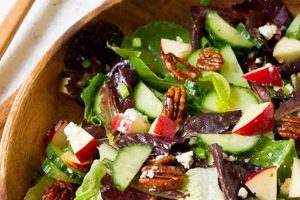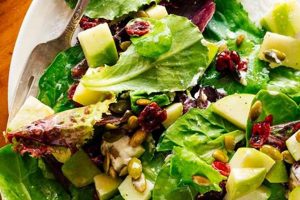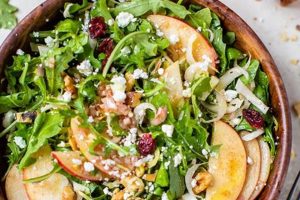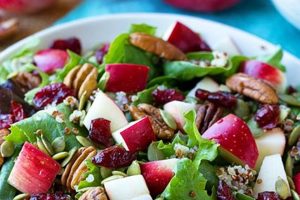This dish typically combines diced apples, chopped Snickers candy bars, and a creamy dressing, often made with whipped cream or Cool Whip, sometimes incorporating other ingredients like grapes, nuts, or marshmallows. Variations exist, offering a range of flavor profiles and textures, from the traditional sweet and creamy version to those with a tangier twist from the addition of yogurt or sour cream.
Its appeal lies in the contrasting textures and flavors: the crispness of the apple, the satisfying chewiness of the nougat and caramel in the candy bar, and the smooth richness of the creamy base. This dessert salad often appears at potlucks, holiday gatherings, and family meals, particularly in the Midwestern and Southern United States, holding a nostalgic significance for many. Its simplicity contributes to its enduring popularity, requiring readily available ingredients and minimal preparation time. The dish offers an opportunity to explore creative variations, tailoring sweetness and texture to individual preferences.
Further exploration could delve into specific ingredient choices, detailed preparation methods, historical and cultural context, nutritional information, and variations suitable for specific dietary needs or preferences.
Tips for an Exceptional Apple Snickers Salad
Optimizing ingredient selection and preparation techniques can elevate this classic dessert salad from simple to extraordinary. Attention to detail ensures a balanced flavor profile and pleasing textural contrast.
Tip 1: Apple Selection: Opt for firm, tart apples such as Granny Smith or Honeycrisp. These varieties hold their shape well and provide a refreshing counterpoint to the sweetness of the other ingredients.
Tip 2: Snickers Preparation: Chill Snickers bars thoroughly before chopping to minimize sticking and ensure clean cuts. Consider using a serrated knife for optimal results.
Tip 3: Dressing Considerations: While traditional recipes often call for whipped cream or Cool Whip, Greek yogurt or a combination of yogurt and whipped cream offers a tangier, less sweet alternative. Adjust sweetness by incorporating powdered sugar or honey.
Tip 4: Enhancing Texture and Flavor: Toasted nuts, such as pecans or walnuts, add a satisfying crunch and depth of flavor. Dried cranberries or chopped grapes introduce a burst of sweetness and a pleasant chewiness.
Tip 5: Balancing Sweetness: A touch of acidity can balance the overall sweetness. A squeeze of lemon juice in the dressing or the addition of tart berries can achieve this balance.
Tip 6: Serving Suggestions: Serve the salad chilled for optimal flavor and texture. Individual portions can be presented in elegant dessert glasses for a more formal presentation.
Tip 7: Storage: To maintain optimal freshness, store the salad in an airtight container in the refrigerator. It is best served within 24 hours of preparation to prevent the apples from becoming overly soft.
By following these suggestions, one can create a truly memorable version of this beloved dessert, enhancing both its visual appeal and flavor complexity.
These insights provide a foundation for creating an apple Snickers salad that caters to individual preferences, balancing sweetness, texture, and presentation for an enjoyable culinary experience.
1. Apples (Granny Smith, Honeycrisp)
Apple selection significantly influences the overall balance and success of this dessert salad. Granny Smith and Honeycrisp varieties are frequently favored due to their specific characteristics. Their firm texture ensures they maintain their shape and provide a satisfying crunch even after being combined with the other ingredients. This textural integrity contrasts pleasantly with the creamy dressing and the softer consistency of the Snickers bar. Furthermore, the tartness of these apple varieties offers a crucial counterpoint to the sweetness of the candy and dressing, preventing the final dish from becoming overly sugary. Using a sweeter apple variety might result in a cloying sweetness, while a softer apple could disintegrate into the salad, creating an undesirable texture.
Consider a scenario where Red Delicious apples are substituted. Their softer texture would likely break down, resulting in a mushy salad. Their sweeter flavor profile would also amplify the overall sweetness of the dish, potentially overwhelming the other components. Conversely, the tartness of Granny Smith apples enhances the caramel and nougat notes of the Snickers, creating a more complex and balanced flavor profile. The Honeycrisp, with its balanced sweetness and tartness, offers a similar benefit while adding a unique honeyed flavor dimension.
The judicious choice of apple variety is thus essential for a successful outcome. Granny Smith and Honeycrisp apples, with their firm texture and tart flavor profiles, offer a desirable contrast to the other components, resulting in a balanced and enjoyable dessert salad. Understanding the interplay of these flavors and textures empowers one to create a dish that is both delicious and structurally sound. Neglecting this crucial element risks compromising the overall quality and enjoyment of the final product.
2. Snickers Bars
Snickers bars play a pivotal role in this dessert salad, contributing significantly to its characteristic flavor and textural profile. The combination of nougat, caramel, peanuts, and milk chocolate provides a complex sweetness and a satisfying chewiness. This textural element contrasts with the crispness of the apples and the smoothness of the creamy dressing, creating a multi-dimensional sensory experience. The inherent sweetness of the Snickers bar necessitates careful balancing with tart apples and, potentially, a less sweet dressing. Omitting or substituting the Snickers bar would fundamentally alter the dish’s identity, resulting in something altogether different.
Consider a scenario where a different chocolate bar is substituted, such as a plain milk chocolate bar. The absence of nougat, caramel, and peanuts would simplify the flavor profile, diminishing the complexity of the salad. A milk chocolate bar also lacks the same textural contrast provided by the Snickers. Similarly, substituting a chocolate bar with nuts and caramel but without nougat would impact the overall chewiness and mouthfeel. The specific composition of the Snickers bar, therefore, is crucial for achieving the desired balance of flavors and textures in this dessert salad. The interplay of the Snickers components with the other ingredients establishes a specific flavor profile that is difficult to replicate with substitutions.
The Snickers bar’s role extends beyond its individual components. It introduces a pre-existing flavor profile familiar to many, adding a layer of recognition and comfort to the dish. This familiarity contributes to the dessert’s widespread appeal and nostalgic associations. Attempting to replicate this effect with other ingredients presents a significant challenge, highlighting the unique contribution of the Snickers bar to this specific culinary creation. Understanding this integral role provides insight into the recipe’s enduring popularity and underscores the importance of selecting authentic Snickers bars for an optimal outcome. Ignoring this aspect could result in a diminished sensory experience, failing to capture the distinctive qualities that define this classic dessert salad.
3. Creamy Base (Whipped Cream, Yogurt)
The creamy base forms an integral part of the apple snickers salad recipe, binding the disparate elements and contributing significantly to the overall texture and flavor profile. This component provides the necessary moisture and richness, counterbalancing the crispness of the apples and the chewiness of the Snickers bar. The choice of creamy base significantly influences the final dish’s sweetness, tanginess, and overall sensory experience.
- Traditional Sweetness: Whipped Cream/Cool Whip
Whipped cream or Cool Whip represents the traditional choice, offering a light, airy texture and a pronounced sweetness that complements the Snickers bar. This option contributes to the classic, nostalgic character of the dessert, providing a familiar and comforting flavor profile. However, it can also contribute to an overly sweet outcome if not balanced with sufficiently tart apples.
- Tangy Balance: Yogurt
Yogurt, particularly Greek yogurt, offers a tangier alternative. Its higher acidity provides a refreshing counterpoint to the sweetness of the Snickers and any added sugars in the recipe. The thicker texture of Greek yogurt also lends a certain richness and body to the salad. This option caters to those who prefer a less sweet and more balanced flavor profile.
- Customization and Flavor Combinations: Blended Options
Blending whipped cream and yogurt allows for customization of both sweetness and texture. This approach offers a middle ground, combining the lightness of whipped cream with the tang of yogurt. Further flavor enhancements can be achieved by incorporating extracts like vanilla or almond, or by adding a touch of citrus zest.
- Dietary Adaptations: Dairy-Free Alternatives
For those with dietary restrictions, dairy-free whipped toppings or coconut cream offer viable alternatives. These options allow individuals to enjoy the dessert while adhering to specific dietary needs. However, flavor and texture profiles may differ, requiring adjustments to other ingredients to achieve the desired balance.
The creamy base acts as a unifying element within the apple snickers salad, harmonizing the diverse textures and flavors. Careful selection of this component, whether traditional or adapted, allows for a tailored sensory experience, balancing sweetness and tartness while catering to individual preferences and dietary requirements. Ultimately, the creamy base plays a crucial role in determining the overall success and enjoyment of this classic dessert.
4. Optional additions (nuts, grapes)
Optional additions, such as nuts and grapes, offer opportunities to enhance both the textural and flavor complexity of the apple Snickers salad. These additions introduce contrasting elements that build upon the existing foundation of crisp apples, chewy Snickers, and creamy dressing. Nuts, particularly toasted varieties like pecans or walnuts, contribute a satisfying crunch and a deeper, more savory flavor profile. Their inherent oils and complex flavor compounds complement the sweetness of the Snickers and the tartness of the apples. Grapes, whether red or green, offer a burst of juicy sweetness and a slightly firm texture, contrasting with the other elements. The inclusion of grapes also introduces visual appeal through color variation.
Consider the impact of adding toasted pecans. The toasting process intensifies the pecans’ inherent nutty flavor, creating a more pronounced contrast to the sweeter elements. The crunch of the pecans provides a textural counterpoint to the softer components, preventing the salad from becoming overly homogenous in texture. Similarly, the addition of red grapes introduces a pop of color and a juicy burst of sweetness, offering a textural variation distinct from both the apples and the Snickers. These additions, while optional, demonstrate the potential for customization and flavor enhancement within the basic recipe framework. Omitting these additions results in a simpler, perhaps less nuanced flavor profile, while including them elevates the salad to a more complex and sophisticated level.
Strategic use of optional additions allows for tailoring the apple Snickers salad to specific preferences. Individuals seeking a more pronounced textural contrast might favor the inclusion of nuts, while those desiring a brighter, more refreshing element might opt for grapes. Understanding the impact of these additions empowers individuals to create variations that best suit their individual tastes. The interplay of these optional components with the core ingredients highlights the dynamic nature of this dessert salad, showcasing its adaptability and potential for personalized culinary expression.
5. Balancing sweetness/tartness
Balancing sweetness and tartness is paramount in achieving a harmonious flavor profile within an apple Snickers salad. The inherent sweetness of the Snickers bar, derived from the milk chocolate, nougat, caramel, and peanuts, requires a careful counterpoint to prevent the dessert from becoming cloying. This balance is primarily achieved through the judicious selection of apple varieties and the considered composition of the creamy dressing. Tart apples, such as Granny Smith or Honeycrisp, provide the necessary acidity to offset the Snickers’ sweetness. Their crisp texture also offers a contrasting sensory experience. The creamy base, whether whipped cream, yogurt, or a combination, contributes to the overall sweetness and can be further adjusted through the addition of sugar or honey. A touch of acidity in the dressing, perhaps from a squeeze of lemon juice, can further enhance the balance.
Consider a scenario where excessively sweet apples, such as Fuji or Red Delicious, are used. The resulting salad would likely lack the necessary tartness to balance the Snickers, resulting in an overly sweet and potentially less enjoyable dessert. Conversely, an extremely tart dressing, perhaps one relying solely on plain yogurt without any added sweetener, could overwhelm the other flavors, creating a disharmony in the flavor profile. A successful apple Snickers salad relies on a careful calibration of these contrasting elements. The interplay between the sweet and tart components creates a dynamic flavor experience, preventing any single element from dominating and ensuring a more nuanced and satisfying outcome.
The principle of balancing sweetness and tartness extends beyond mere preference; it reflects a fundamental aspect of culinary composition. Achieving this balance elevates the apple Snickers salad from a simple combination of ingredients to a carefully constructed dessert that engages the palate on multiple levels. This understanding allows for informed ingredient selection and recipe adaptation, empowering individuals to create versions tailored to their specific tastes while adhering to the underlying principle of balanced flavors. This principle’s practical application highlights the importance of considering the interplay of different flavor profiles in any culinary endeavor, demonstrating that a well-balanced dish is not merely a matter of chance but a result of deliberate and informed choices.
6. Chilling and serving
Chilling plays a crucial role in optimizing the sensory experience of an apple Snickers salad. Refrigeration enhances the textural contrast between the components. Chilled apples maintain their crispness, offering a refreshing counterpoint to the softened texture of the chilled Snickers bar. The creamy base, whether whipped cream or yogurt, also benefits from chilling, developing a firmer consistency that enhances its mouthfeel. Furthermore, chilling allows the flavors to meld, creating a more cohesive and balanced flavor profile. A warm Snickers salad would likely present a less appealing textural experience, with the chocolate and caramel becoming overly soft and the apples potentially losing their crispness. The creamy base might also become runny at warmer temperatures, detracting from the overall enjoyment.
Consider a scenario where the salad is served immediately after preparation without chilling. The Snickers bar may be overly chewy, the apples may lack their characteristic crunch, and the creamy base may have a less desirable consistency. Conversely, adequate chilling ensures that the flavors and textures are at their peak, providing a more satisfying sensory experience. The cold temperature also enhances the perception of sweetness and tartness, creating a more dynamic interplay of flavors. Serving temperature, therefore, significantly influences the overall perception and enjoyment of the apple Snickers salad. Practical applications of this understanding include preparing the salad well in advance of serving to allow sufficient chilling time and ensuring the refrigerator temperature is appropriately set to achieve optimal results.
The act of serving the apple Snickers salad also contributes to the overall experience. Presentation in individual dessert glasses or a decorative serving bowl enhances visual appeal. Garnishing with a sprinkle of chopped nuts or a dollop of whipped cream further elevates the presentation. Serving chilled minimizes temperature fluctuations, preserving the desired textures and flavors. Ultimately, attention to both chilling and serving practices contributes to a more enjoyable and aesthetically pleasing culinary experience, demonstrating that careful consideration of these elements elevates the simple act of consuming a dessert salad to a more refined and satisfying event.
Frequently Asked Questions
This section addresses common inquiries regarding the preparation and characteristics of this dessert salad.
Question 1: What type of apple is best suited for this recipe?
Firm, tart apples such as Granny Smith or Honeycrisp are recommended. These varieties hold their shape well and provide a necessary contrast to the sweetness of the other ingredients. Softer, sweeter apples may become mushy and create an overly sweet final product.
Question 2: Can other types of candy bars be substituted for Snickers?
While substitutions are possible, the unique combination of nougat, caramel, peanuts, and milk chocolate in Snickers bars contributes significantly to the dish’s characteristic flavor profile. Substituting other candy bars may result in a different, potentially less balanced, outcome.
Question 3: What are the alternatives for the creamy base if whipped cream is not preferred?
Greek yogurt, or a combination of yogurt and whipped cream, offers a tangier and less sweet alternative. Dairy-free whipped toppings or coconut cream can be used for those with dietary restrictions.
Question 4: How long can the salad be stored in the refrigerator?
For optimal quality, this dessert salad is best consumed within 24 hours of preparation. Beyond this timeframe, the apples may soften excessively, and the overall texture and flavor may deteriorate.
Question 5: Can this salad be made ahead of time for a gathering?
Yes, the salad can be prepared several hours in advance and chilled thoroughly. However, its generally recommended to add the Snickers shortly before serving to prevent them from becoming overly soft.
Question 6: How can the sweetness of the salad be adjusted?
Sweetness can be adjusted through several methods. Using a less sweet creamy base, such as yogurt, reducing added sugar, or incorporating a touch of lemon juice to the dressing can help balance the overall sweetness.
Understanding these aspects ensures successful preparation and a satisfying culinary experience.
This concludes the frequently asked questions section. The following section will offer a selection of variations on the classic recipe.
Apple Snickers Salad Recipe
This exploration has provided a comprehensive understanding of the apple snickers salad recipe, from its core components and preparation methods to variations and serving suggestions. Emphasis has been placed on the importance of ingredient selection, particularly the balance between the tartness of the apples and the sweetness of the Snickers bar. The role of the creamy base in unifying the dish and the potential for customization through optional additions have also been examined. Proper chilling and serving techniques have been highlighted as crucial factors in optimizing the final sensory experience. Addressing frequently asked questions has provided practical solutions to common challenges encountered during preparation.
The enduring popularity of this dessert salad speaks to its ability to satisfy a range of palates with its contrasting textures and balanced flavors. Further experimentation with ingredient variations and flavor combinations offers continued culinary exploration. Ultimately, a thorough understanding of the underlying principles governing this seemingly simple dish allows for consistent successful outcomes and the creation of personalized variations that cater to individual preferences.






